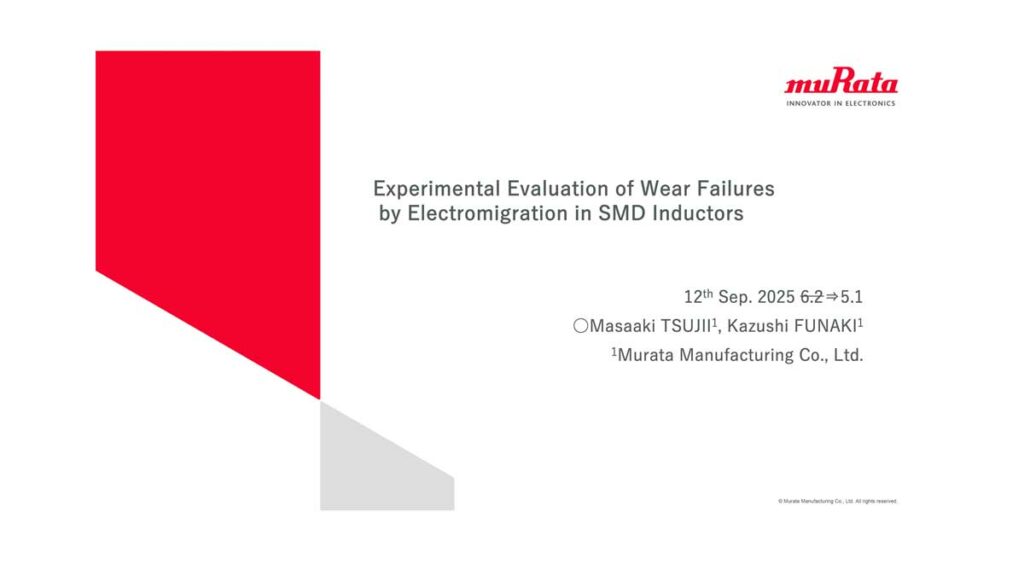The paper “Experimental Evaluation of Wear Failures in SMD Inductors” was presented by Masaaki Tsujii, Murata Manufacturing Co., Ltd., Kyoto, Japan at the 5th PCNS Passive Components Networking Symposium 9-12th September 2025, Seville, Spain as paper No. 6.2.
Introduction
The rapid electrification of the automotive industry and the rise of autonomous driving technologies have significantly increased the operational demands placed on automotive electronic components.
With vehicle lifetimes extending to 10–20 years, ensuring long-term component reliability has become critical. A key approach to this challenge is Mission Profile validation, which defines the environmental and operational conditions components will face throughout their service life.
Surface-mounted device SMD inductors, such as multilayer ferrite beads, are widely used in automotive systems but have been less studied in terms of wear failure mechanisms under realistic Mission Profile conditions. This study investigates the high-temperature, high-current wear failure behavior of multilayer ferrite SMD inductors.
Key Points
- Mission Profile assessments simulate environmental and operational stresses to predict long-term component reliability.
- Multilayer ferrite beads with screen-printed Ag internal coils and Ni/Sn external electrodes were tested under high-stress conditions.
- Experiments involved 10 A DC current at 150 °C, far exceeding the normal rated current.
- Failures were associated with electromigration, intermetallic compound (IMC) formation, and void generation.
- DC resistance increased after 200 hours due to IMC growth and voiding, leading toward potential thermal runaway and open failure.
Extended Summary
The study began by acknowledging the growing importance of Mission Profile-based validation in the automotive sector, emphasizing the lack of detailed data on SMD inductor wear failures. To explore these mechanisms, Murata fabricated prototype multilayer ferrite beads featuring two straight internal Ag coil layers and Ni/Sn-plated external electrodes. These inductors were mounted on evaluation boards using Sn-3.0Cu-0.5Ag solder and stressed in a 150 °C chamber with 10 A applied current to accelerate failure mechanisms.
Initial cross-sectional imaging confirmed the baseline structure of the inductors, with uniform Ni plating and intact Ag paste layers. For approximately 200 hours, the DC resistance remained stable, after which it began to rise. SEM and EDX analysis after 600 hours revealed polarity-dependent material migration: on the anode side, Cu and Sn intermetallics formed along the Ni plating, while on the cathode side, Ni plating was partially depleted, and Cu/Ni intermetallics developed in the solder outside the fillet. Voids were observed along the cathode external electrode, coinciding with regions of Ni loss.
The observed behavior was linked to electromigration, whereby electron flow drives Cu and Ni diffusion according to current polarity. Ni migration from the cathode toward the substrate land and Sn diffusion into the Ag paste layer led to the formation of high-resistivity intermetallic compounds. This progression caused the increase in DC resistance over time, and the voids further contributed to resistive growth. If allowed to continue, this process could result in localized heating, thermal runaway, and complete open failure.
The study also highlighted the significant role of Sn crystallographic orientation in Ni diffusion rates, explaining the uneven distribution of IMCs. The combined effects of IMC growth and void formation under accelerated conditions provide critical insight into the failure mechanisms of SMD inductors during long-term service in automotive applications.
Conclusion
This experimental evaluation demonstrated that under high-temperature, high-current stress, multilayer ferrite SMD inductors exhibit wear failures driven by electromigration. Key mechanisms include polarity-dependent diffusion of Cu and Ni, Ni plating depletion, Sn infiltration into the Ag paste layer, and intermetallic compound formation accompanied by voiding. The resulting increase in DC resistance signals the onset of potential thermal runaway and eventual open failure. This research lays the groundwork for developing accurate acceleration models, identifying countermeasures, and designing more robust inductors for the next generation of automotive electronics.
